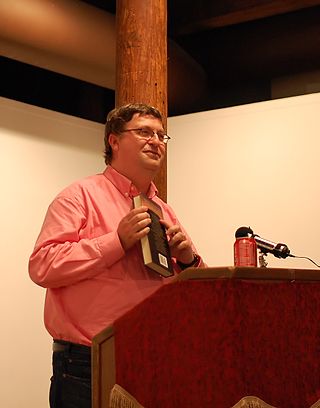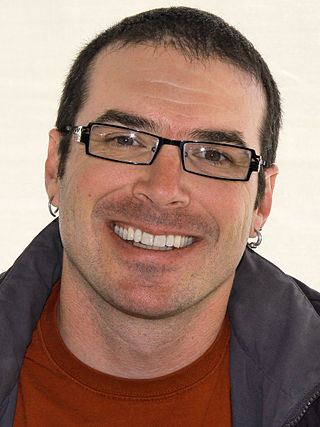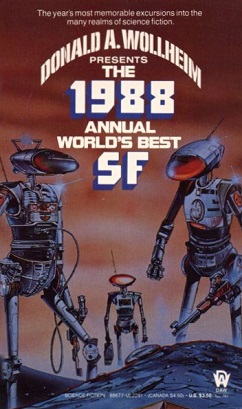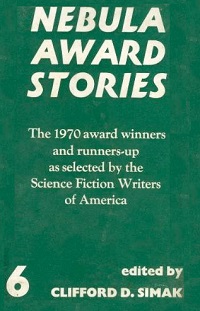Related Research Articles
Sci Fiction was an online magazine which ran from 2000 to 2005. At one time, it was the leading online science fiction magazine. Published by Syfy and edited by Ellen Datlow, the work won multiple awards before it was discontinued.

"The Martian Child" is a novelette by American writer David Gerrold, originally published in Fantasy & Science Fiction. It won the 1995 Hugo Award for Best Novelette, Locus Award and HOMer Award and the 1994 Nebula Award for Best Novelette and was nominated for the Theodore Sturgeon award for best short fiction. The novelette was expanded into a novel and made into an eponymous film.

Andy Duncan is an American science fiction and fantasy writer whose work frequently deals with Southern U.S. themes.
"The Little Black Bag" is a science fiction novelette by American writer Cyril M. Kornbluth, first published in the July 1950 edition of Astounding Science Fiction. It won the 2001 Retroactive Hugo Award for Best Novelette and was also recognized as the 13th best all-time short science fiction story in October and November 1971 Analog Science Fact & Fiction poll, The Reference Library review article, tied with "Microcosmic God" by Theodore Sturgeon. It was among the stories selected in 1970 by the Science Fiction Writers of America as one of the best science fiction short stories published before the creation of the Nebula Awards. As such, it was published in The Science Fiction Hall of Fame Volume One, 1929–1964.

Paolo Tadini Bacigalupi is an American science fiction and fantasy writer. He has won the Hugo, Nebula, John W. Campbell Memorial, Compton Crook, Theodore Sturgeon, and Michael L. Printz awards, and has been nominated for the National Book Award. His fiction has appeared in The Magazine of Fantasy & Science Fiction, Asimov's Science Fiction, and the environmental journal High Country News. Nonfiction essays of his have appeared in Salon.com and High Country News, and have been syndicated in newspapers, including the Idaho Statesman, the Albuquerque Journal, and The Salt Lake Tribune.
"Microcosmic God" is a science fiction novelette by American writer Theodore Sturgeon. Originally published in April 1941 in the magazine Astounding Science Fiction, it was recognized as one of the best science fiction short stories published before the Nebula Awards by the Science Fiction Writers of America in 1970, and was named as one of the best science fiction stories in polls by Analog Science Fiction and Fact in 1971 and Locus in 1999. In 1976, it was also published as a comic book version in issue 3 of Starstream: Adventures in Science Fiction, a comic anthology in four issues by Gold Key Comics.

The 1987 Annual World's Best SF is an anthology of science fiction short stories edited by Donald A. Wollheim and Arthur W. Saha, the fourteenth volume in a series of nineteen. It was first published in paperback by DAW Books in June 1987, followed by a hardcover edition issued in July of the same year by the same publisher as a selection of the Science Fiction Book Club. For the hardcover edition the original cover art by Tony Roberts was replaced by a new cover painting by Richard Powers.

The 1988 Annual World's Best SF is an anthology of science fiction short stories edited by Donald A. Wollheim and Arthur W. Saha, the seventeenth volume in a series of nineteen. It was first published in paperback by DAW Books in June 1988, followed by a hardcover edition issued in August of the same year by the same publisher as a selection of the Science Fiction Book Club. For the hardcover edition the original cover art by Blair Wilkins was replaced by a new cover painting by Richard Powers.

The 1989 Annual World's Best SF is an anthology of science fiction short stories edited by Donald A. Wollheim and Arthur W. Saha, the eighteenth volume in a series of nineteen. It was first published in paperback by DAW Books in June 1989, followed by a hardcover edition issued in September of the same year by the same publisher as a selection of the Science Fiction Book Club. For the hardcover edition the original cover art by Jim Burns was replaced by a new cover painting by Richard M. Powers.

World's Best Science Fiction: 1971 is an anthology of science fiction short stories edited by Donald A. Wollheim and Terry Carr, the seventh volume in a series of seven. It was first published in paperback by Ace Books in 1971, followed by a hardcover edition issued in September of the same year by the same publisher as a selection of the Science Fiction Book Club. It was followed in 1972 by The 1972 Annual World's Best SF, edited by Wollheim, and The Best Science Fiction of the Year, edited by Carr, the first volumes of two separate successor series,

The Best Science Fiction of the Year 1 is an anthology of science fiction short stories edited by Terry Carr, the initial volume in a series of sixteen. It was one of two follow-up volumes to the previous year's World's Best Science Fiction: 1971 edited by Carr in collaboration with Donald A. Wollheim for Ace Books, the other being Wollheim's The 1972 Annual World's Best SF, edited by Wollheim and Arthur W. Saha. The Carr title was first published in paperback as The Best Science Fiction of the Year by Ballantine Books in July 1972. It was reissued by Ballantine in April 1976 as The Best Science Fiction of the Year #1, in keeping with the numerical designations of subsequent volumes in the series.

Terry Carr's Best Science Fiction and Fantasy of the Year #16 is an anthology of science fiction short stories edited by Terry Carr, the sixteenth and last volume in a series of sixteen. It was first published in hardcover by Tor Books in September 1987. The first British editions were published in hardcover and paperback by Gollancz in December of the same year, under the alternate title Best SF of the Year #16.

Universe 1 is an anthology of original science fiction short stories edited by Terry Carr, and illustrated by Alicia Austin, the initial volume in a series of seventeen. It was first published in paperback by Ace Books in 1971, with a British hardcover facsimile edition following from Dennis Dobson in 1975.
Lightspeed is an American online fantasy and science fiction magazine edited and published by John Joseph Adams. The first issue was published in June 2010 and it has maintained a regular monthly schedule since. The magazine published four original stories and four reprints in every issue, in addition to interviews with the authors and other nonfiction. All of the content published in each issue is available for purchase as an ebook and for free on the magazine's website. Lightspeed also made selected stories available as a free podcast, produced by Audie Award–winning editor Stefan Rudnicki.
Rachel Swirsky is an American literary, speculative fiction and fantasy writer, poet, and editor living in Oregon. She was the founding editor of the PodCastle podcast and served as editor from 2008 to 2010. She served as vice president of the Science Fiction and Fantasy Writers of America in 2013.

Nebula Award Stories 6 is an anthology of award-winning science fiction short works edited by Clifford D. Simak. It was first published in the United Kingdom in hardcover by Gollancz in November 1971. The first American edition was published by Doubleday in December of the same year. Paperback editions followed from Pocket Books in the U.S. in 1972, and Panther in the U.K. in December 1973. The American editions bore the variant title Nebula Award Stories Six. The book has also been published in German.
Sarah Pinsker is an American science fiction and fantasy author. She is a nine-time finalist for the Nebula Award, and her debut novel A Song for a New Day won the 2019 Nebula for Best Novel while her story "Our Lady of the Open Road won the 2016 Nebula Award for Best Novelette. Her novelette "Two Truths and a Lie" received both the Nebula Award and the Hugo Award. Her fiction has also won the Philip K. Dick Award, the Theodore Sturgeon Award and been a finalist for the Hugo, World Fantasy, and Tiptree Awards.

Sam J. Miller is an American science fiction, fantasy and horror short fiction author. His stories have appeared in publications such as Clarkesworld, Asimov's Science Fiction, and Lightspeed, along with over 15 "year's best" story collections. He was finalist for multiple Nebula Awards along with the World Fantasy and Theodore Sturgeon Awards. He won the 2013 Shirley Jackson Award for his short story "57 Reasons for the Slate Quarry Suicides." His debut novel, The Art of Starving, was published in 2017 and his novel Blackfish City won the 2019 John W. Campbell Memorial Award.
"Rachel in Love" is a 1987 science fiction short story by American writer Pat Murphy. It was first published in Asimov's Science Fiction.
Dexter Gabriel, better known by his pen name Phenderson Djèlí Clark, is an American speculative fiction writer and historian, who is an assistant professor in the department of history at the University of Connecticut. He uses a pen name to differentiate his literary work from his academic work, and has also published under the name A. Phenderson Clark. This pen name, "Djèlí", makes reference to the griots – traditional Western African storytellers, historians and poets.
References
- 1 2 Slow Sculpture title listing at the Internet Speculative Fiction Database
- 1 2 3 "1971 Hugo Awards". World Science Fiction Society. Retrieved 2010-07-26.
- 1 2 "The Nebula Awards: Previous Winners". Science Fiction and Fantasy Writers of America. Archived from the original on January 7, 2009. Retrieved 2010-07-28.
- 1 2 Diskin 1981, pp. 12-13
- ↑ Diskin 1981, p. 52
- ↑ "1971 Locus Awards". Locus Publications. Retrieved 2010-07-28.